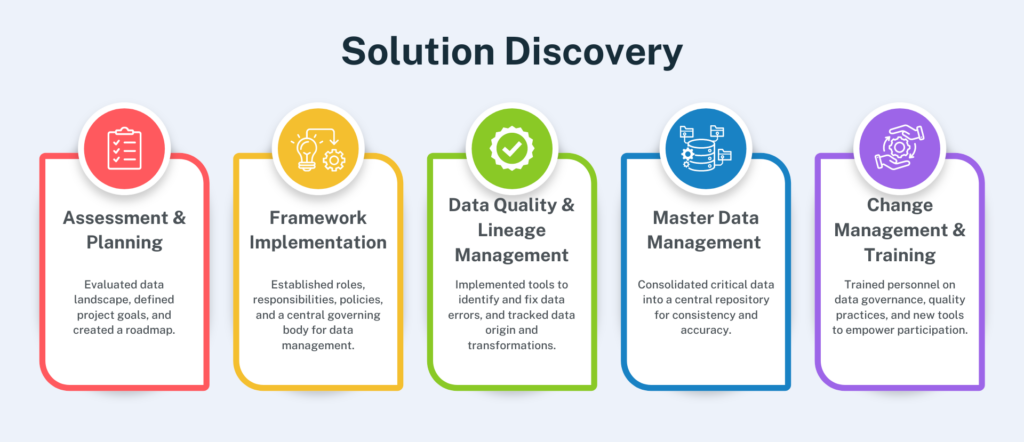CASE STUDY
Data Governance to Overcome Data Challenges in the Financial Industry
Introduction
Founded in 1964, our client is a prominent force in the global financial sector. Their extensive network boasts over 2,000 branches nationwide, serving a diverse clientele of millions – individuals and corporations alike. The bank’s unwavering commitment to exceptional financial services has fueled its consistent growth within the competitive banking landscape.
However, as the complexity of their data ecosystem grew, our client recognized the need for a robust data governance framework. This would unlock the true power of their data and ensure a competitive edge in the ever-evolving financial environment. Inconsistent data definitions across departments, inadequate data quality controls, and a lack of centralized data governance practices hampered their ability to leverage data for informed decision-making and regulatory compliance.
The Business Challenge
Our client faced several critical data governance challenges:
- Inconsistent Data Definitions: Different departments used varying terms for the same data points, creating confusion and inaccurate reporting. For instance, “customer address” might be defined differently in the marketing system compared to the loan processing system.
- Limited Data Quality Control: The absence of robust data quality measures resulted in errors and inconsistencies. Dirty data, containing missing values, typos, or outdated information, impacted the reliability of reports and downstream analytics.
- Decentralized Data Governance: Data ownership and accountability were unclear. Without a central governing body, enforcing data standards and ensuring data integrity became difficult.
Regulatory Compliance: Keeping pace with stricter data privacy regulations, such as the Data Protection Bill (DPDPB) in India, added pressure to establish a robust data governance framework.
Overcome Data Challenges with the Experts in Data Governance
Enhance your ability to efficiently manage and leverage your data assets. Contact us now!

Joint Solution Discovery & Implementation Plan
Hoonartek partnered with the client to develop a comprehensive data governance solution using Ab Initio’s data governance suite. Our collaborative approach involved the following key phases:
- Assessment & Planning: We conducted a thorough assessment of our client’s data landscape, identifying data quality issues, data lineage gaps, and governance weaknesses. Through workshops and interviews, we collaborated with the client to define project goals, timelines, and resource allocation. This phase ensured alignment on the desired outcomes and established a roadmap for achieving them.
- Data Governance Framework Implementation: We implemented a data governance framework with clearly defined roles, responsibilities, policies, and procedures for data management. This framework established a central governing body responsible for overseeing data governance practices. Additionally, it outlined data ownership for different data sets, ensuring clear accountability for data quality and accuracy. Standardized data definitions were created to ensure consistent understanding and usage across the bank.
- Data Quality & Lineage Management: We implemented data quality tools to identify and rectify errors in the data. These tools automatically scanned data sets for inconsistencies, missing values, and format errors, enabling data cleansing and improvement. Additionally, we established data lineage tracking to understand the origin and transformation of data throughout its lifecycle. This provided a clear audit trail, ensuring data traceability and facilitating impact analysis when changes were made to data sources or processes.
- Master Data Management (MDM): We implemented a master data management (MDM) solution to consolidate and manage critical customer, product, and reference data across the bank. MDM acts as a central repository for this core data, ensuring consistency and accuracy across all systems. For instance, a single, accurate customer record would be maintained in the MDM system, eliminating the risk of duplicate entries or conflicting information across different applications.
- Change Management & Training: We conducted comprehensive training sessions for our client’s personnel on data governance principles, data quality practices, and the new tools implemented. This empowered employees to actively participate in data governance initiatives. Training covered topics like data quality best practices, data stewardship responsibilities, and the proper use of data governance tools.
Outcomes
The successful implementation of the data governance framework delivered significant benefits for our client, including:
Data Quality, Consistency & Enhanced Data Visibility
- Data quality checks and standardized definitions led to cleaner, more reliable data for analysis and reporting. Error rates in data sets were significantly reduced, boosting data trustworthiness.
- Clear data lineage provided a comprehensive understanding of data origin and transformation. This improved data transparency and facilitated root cause analysis when data quality issues arose.
Streamlined Data Governance & Enhanced Regulatory Compliance
- Defined roles, responsibilities, and workflows improved data management efficiency. With centralized governance and clear ownership structures, data management became more systematic and streamlined.
- The data governance framework positioned the client to meet data privacy and security regulations more effectively. Standardized data practices and centralized data control facilitated compliance audits and reporting.
Data-Driven Decision Making
- Improved data quality empowered the client to make more informed business decisions based on accurate and reliable data. Reliable data analytics led to better customer insights, improved risk management strategies, and optimized product development efforts.
Industry Perspective
The financial services industry is subject to stringent regulations regarding data privacy and security. Our data governance solution was designed not only to address our client’s specific challenges but also to ensure compliance with current and upcoming regulations such as DPDPB. This future-proof approach positioned the client for long-term data management success by establishing a foundation that could adapt to evolving industry standards.
Conclusion
Hoonartek’s collaboration with the client exemplifies the transformative power of data governance. By implementing a comprehensive framework, addressing data quality issues, and fostering a culture of data stewardship, our client achieved significant improvements in data quality, regulatory compliance, and data-driven decision making. This case study demonstrates the tangible benefits that financial institutions can achieve by prioritizing data governance as a strategic imperative.


